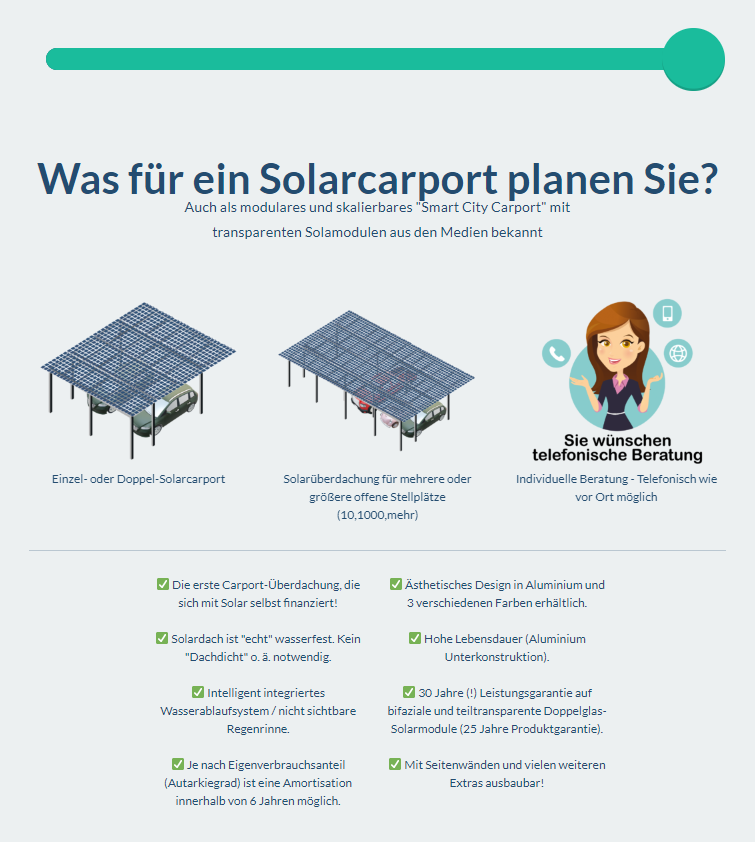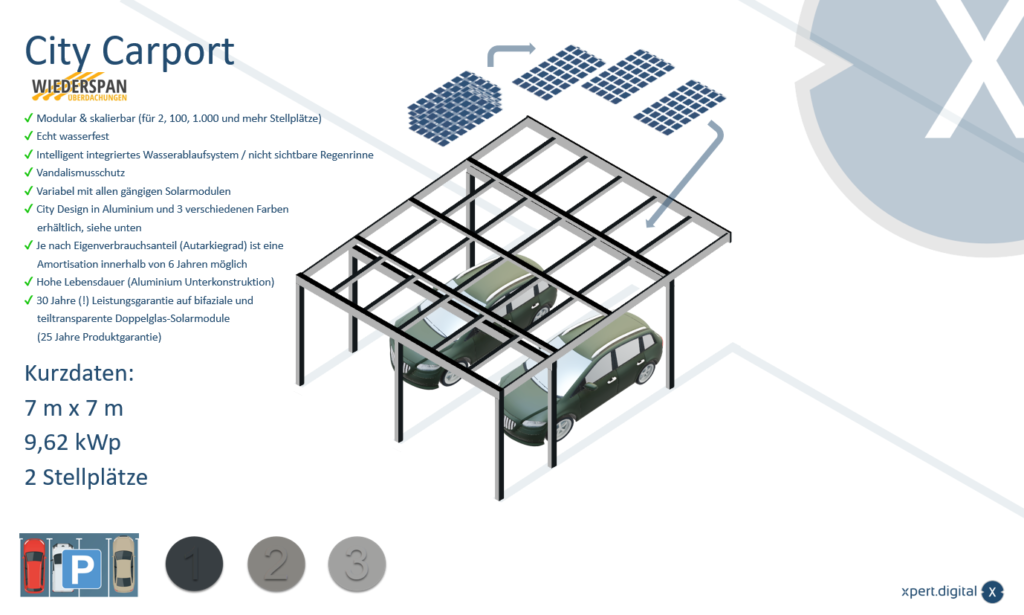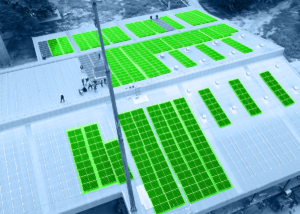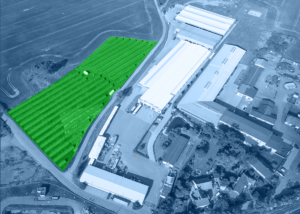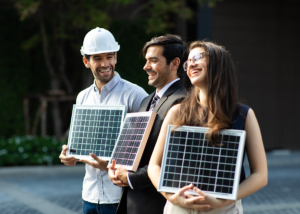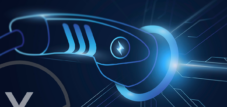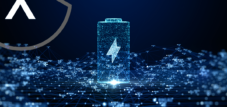Bidirectional charging for energy-independent buildings and halls – the future of electric vehicles and electricity storage
Language selection 📢
Published on: July 27, 2023 / update from: August 21, 2024 - Author: Konrad Wolfenstein

The future of electric vehicles: Bidirectional charging for energy-independent buildings and houses - Image: Xpert.Digital
The three variants of bidirectional charging at a glance
Policy initiatives and innovations for bidirectional charging
In a world increasingly focused on renewable energy sources and sustainable mobility, electric vehicles (EVs) are at the heart of these revolutionary changes. An exciting concept that can take electric mobility to a new level is bi-directional charging of EVs. In this article, we'll look at the topic of bi-directional charging for electric vehicles and how it has the potential to make homes more energy independent.
What is bidirectional charging?
Bidirectional charging refers to the ability of electric vehicles to not only draw energy from the grid, but also feed excess energy back into the grid or into household appliances. Essentially, EV batteries can act as mobile energy storage devices, helping to stabilize the power grid.
The three variants of bidirectional charging
There are three main variants of bidirectional charging that we would like to take a closer look at:
1. Vehicle-to-consumer (V2L)
With the V2L model, the electric vehicle can serve as a power source for electrical devices. The vehicle becomes a mobile generator that supplies energy when it is needed. Imagine being able to power your home electrical appliances directly from the EV when the household power goes out or when you are in a remote area.
2. Vehicle-to-Home (V2H)
The V2H concept allows the electric vehicle to serve as an additional source of energy for the entire home. The EV battery can be charged during low electricity tariff periods and release the stored energy during expensive peak periods. This allows the household to reduce its energy costs and at the same time relieve the strain on the power grid.
3. Vehicle-to-Grid (V2G)
V2G is probably the most exciting variant of bidirectional charging. Here, the electric vehicle becomes part of the power grid itself. During times of high electricity demand, the vehicle can feed excess energy into the grid to meet demand. EV owners thus become active players in the energy system and contribute to the promotion of renewable energies.
Challenges and intelligent energy management systems
Although bidirectional charging is promising, there are some challenges that need to be overcome. One of these is the technical coordination between the different EV models to ensure that the bi-directional charging function works properly.
Another issue is the synchronization of loading and unloading. In order not to overload the grid, intelligent energy management systems must be developed that optimize the flow of energy and take household needs into account.
An important point that should not be ignored is the billing for the energy fed into the grid by the EV. Clear and fair regulations must be developed to promote incentives for bi-directional charging and to fairly reward energy exchange.
The role of laws and regulations
For bi-directional charging to be a success, new laws and regulations are needed to support and advance this technology. It is important that governments and policymakers create incentives to encourage the adoption of two-way charging.
Regulations should also be created to ensure interoperability between different manufacturers and technologies. This would facilitate the development of standardized solutions and smooth integration of EVs into the power grid.
Future outlook
Although bidirectional charging still has some hurdles to overcome, the future is bright. With policy initiatives, technological innovations and financial incentives, this technology will become increasingly important.
The possibility of electric vehicles not only consuming energy but also contributing to the energy supply as active participants is an important step towards a sustainable and decentralized energy future.
➡️ Bi-directional charging of electric vehicles is undoubtedly an exciting development that has the potential to fundamentally change the way we use and distribute energy. The three variants V2L, V2H and V2G offer a wide range of options for a more energy-independent future.
➡️ However, to realize this vision, we must face the challenges and develop intelligent solutions. With supportive legislation and a clear vision, we can create a sustainable energy future where electric vehicles not only take to the streets but also power our homes with clean energy.
The Xpert.Solar solar carport planner
Solar parking spaces are a promising way to generate renewable energy while optimizing limited space requirements in cities and urban areas. However, there are actually some challenges that can complicate the introduction of such parking spaces.
One of the biggest hurdles is the high cost and planning effort associated with installing solar panels in parking lots. Not only must the cost of the solar panels themselves be taken into account, but also the cost of the infrastructure required to connect the panels to the grid. In addition, the space required for installing the solar modules must be precisely planned and coordinated to ensure effective use of the available space.
Another obstacle are bureaucratic hurdles and approval processes that can make it difficult to install solar panels in parking lots. Depending on the region or country, different rules and regulations may apply, which can complicate the approval and implementation process.
Despite these challenges, there is high demand for solar parking spaces as they represent an effective way to promote renewable energy while optimizing space requirements in urban areas. With careful planning and collaboration between the parties involved, the hurdles can be overcome to facilitate the introduction of such parking spaces.
➡️ We specialize in providing advisory and planning support for such solar carport projects and advancing their implementation.
➡️ With our solar carport planner we simplify the process.
➡️ We are there for you for the next steps and thus minimize costs and effort for you.
More about it here:
Renault and Volkswagen: Bidirectional charging for electric cars
Innovative bidirectional charging solutions for electric cars: Renault and Volkswagen are breaking new ground
Electromobility is on the rise, and more and more car manufacturers are recognizing the importance of bi-directional charging solutions for their electric vehicles. Both Renault and Volkswagen have plans to introduce this technology in their electric cars, thereby pushing the boundaries of traditional charging capabilities. In this article, we'll take a closer look at both companies' initiatives and how they could revolutionize electric mobility.
Renault and the electric R5 with bi-directional charging
Renault has ambitious plans to take electromobility to a new level with the upcoming electric R5. The Renault R5 is expected to launch in late 2024 and will feature bi-directional charging. What does that mean exactly?
The groundbreaking technology of bi-directional charging allows the R5 to not only absorb energy, but also release it again. This makes the electric car a type of energy storage that can flow energy back into the power grid during times of high electricity prices. The management of the energy transactions is taken over by The Mobility House, which ensures efficient and reliable processing. But that's not all.
The Renault R5 will also be equipped with a so -called “Mobilize Powerbox Wallbox”. This intelligent wall box enables the driver to load the electric car flexibly and market -oriented in order to benefit from cheaper electricity tariffs. This not only relieves the owner of the R5, but also stabilizes the power grid.
Volkswagen and the bidirectional charging technology for the ID series
Volkswagen is also guided by the vision of bidirectional charging and is already busy integrating this technology into the ID series. Here, Volkswagen relies on direct current (DC) instead of alternating current (AC) for bidirectional charging. The ID series already supports bi-directional DC charging according to the ISO 15118-20 standard, and integration of AC charging is planned for the future.
By using direct current, Volkswagen can ensure high efficiency when charging and discharging the vehicle battery. This type of charging is also compatible with photovoltaic systems and traction batteries, which offers additional options for using renewable energies. However, the integration of DC charging infrastructure still represents a challenge because the corresponding wallboxes are cost-intensive.
Volkswagen is working hard to bring its bi-directional charging solution to market soon. A cooperation with E3/DC for a DC-based V2G wallbox could possibly be considered. However, successful implementation also depends on the political framework.
Political challenges and outlook
In order for bi-directional charging of electric cars to become a reality and realize its full potential, certain regulatory obstacles must be overcome. In particular, the exemption from taxes for mobile energy storage (traction batteries) and the smooth integration into the energy market are of crucial importance.
Policymakers must recognize the importance and potential of this technology and take appropriate action to enable widespread adoption. Through clever and forward-looking policies, electromobility in Germany and Europe can receive a further boost.
The future of bidirectional charging
Both Renault and Volkswagen have big plans to introduce bi-directional charging solutions in their electric cars. Bidirectional charging technology promises a variety of benefits for electromobility, from reducing the load on the power grid to integrating renewable energies.
However, the introduction of this groundbreaking technology requires not only the commitment of car manufacturers, but also political support. Only through close collaboration between everyone involved can the full potential of bidirectional charging be unlocked.
We can look forward to a promising future of electromobility in which bi-directional charging will play a central role. Renault and Volkswagen are pointing the way in this promising direction with their initiatives.
Tailor-made energy projects: AC/DC or just DC-side planning and installation also for third parties - let us help you achieve your goals
More about it here:
The Future of Bidirectional Charging for Electric Vehicles (EVs): Benefits and Challenges
In this section, we aim to provide a comprehensive insight into the emerging technology of bi-directional charging for electric vehicles (EVs). Bi-directional charging allows EVs to exchange energy with the grid, bringing a variety of benefits such as using renewable energy in the home and providing backup power. While Germany is slowly catching up with Asian countries in this area, we still face some challenges in defining interfaces and developing hardware and software for vehicle-to-grid (V2G) and vehicle-to-home (V2H) applications. In this article, we will also look at the progress that German and European car manufacturers are making in testing bi-directional charging and explore the potential of this technology.
The current situation of bidirectional charging
Bidirectional charging currently requires specialized wallboxes with DC connections. These enable electricity to flow between the EV and the power grid in both directions. However, it is important to note that future EVs with Type 2 ports will support this functionality natively. This makes the use of bi-directional charging accessible to a wider range of electric vehicles and makes it easier to integrate into the everyday life of EV owners.
The ISO15118 standard plays a crucial role, enabling communication between the electric vehicles and the wallboxes. Through this standard, information about the available energy, charging power and other relevant data is exchanged between the vehicle and the charging station to ensure efficient and safe energy transmission.
Advantages of bidirectional charging
Use of renewable energy in the home
The ability to export energy from the EV to the grid provides a great opportunity to store and utilize excess energy from renewable sources. If your home is equipped with a photovoltaic system, you can store the solar energy generated during the day in your vehicle and recycle it back into the house later in the evenings or when needed. This maximizes your own consumption of clean energy and reduces the need for electricity from the public grid.
Emergency power supply and energy independence
Bi-directional charging allows you to use your EV as a backup power source for your home during times of power outages. In emergencies, you can use your electric vehicle as a backup power source to power essential appliances and household appliances. This provides a high level of security and independence, especially in regions where power outages are more common.
Contribution to grid stabilization
Widespread adoption of bidirectional charging technologies can also help stabilize the power grid. The ability to feed excess energy from EVs back into the grid can reduce the need for additional energy storage. In times of high demand, the network can be relieved in this way, resulting in a better balance between electricity generation and consumption.
Challenges and future developments
Despite the promising benefits of bidirectional charging, we face some challenges in implementing and disseminating this technology.
Definition of uniform interfaces
The introduction of a uniform standard for the interfaces between the EVs and the charging stations is crucial. Uniform interfaces ensure the interoperability of different vehicles and charging stations and facilitate seamless integration into the power grid. The already mentioned ISO15118 standard plays a central role here, but further efforts are required to achieve full harmonization.
Development of suitable hardware and software
Developing reliable hardware and software for bidirectional charging stations is another challenge. The wallboxes must ensure that energy is transferred efficiently and safely to avoid damage to the vehicles or the power grid. In addition, the implementation of advanced control software is required to optimize the energy flow and ensure reliable communication between the components involved.
Integration into the power grid
The extensive integration of bidirectional charging into the power grid requires extensive planning and coordination with energy suppliers. Grid operators must make the necessary adjustments to enable bidirectional energy transmission while ensuring the stability and reliability of the power grid.
➡️ Bidirectional charging of electric vehicles has enormous potential to increase energy efficiency, use renewable energy and increase independence from external power sources. Combining bidirectional charging with photovoltaic systems can help shape a sustainable energy future. Although there are still challenges to be overcome, progress in the development of this technology is promising, and German and European car manufacturers are playing an important role in the research and implementation of bi-directional charging.
Let's work together towards a sustainable future
Our favorite city solar carport or solar carport module
The advantages at a glance
- Support & Made in Germany
- Modular & scalable (for 2, 100, 1,000 and more parking spaces)
- Really waterproof
- Integrated water drain / invisible rain gutter
- Vandalism protection, optionally with integrated impact protection
- Variable with all common solar modules
- City design available in aluminum and 3 different colors
- Depending on the amount of self-consumption (degree of self-sufficiency), amortization is possible within 6 years
- Long service life (aluminum substructure)
- 30-year (!) performance guarantee on bifacial and partially transparent double-glass solar modules (25-year product guarantee)
- Reducing urban heat islands
- Building-integrated photovoltaics
- Ideal for transparent and translucent double-glass solar modules with overhead mounting approval!
- Warehouses, production halls and industrial halls with their own power source from a photovoltaic roof system - Image: NavinTar|Shutterstock.com
- Industrial plant with its own power source from an outdoor photovoltaic system - Image: Peteri|Shutterstock.com
- Plan solar systems with photovoltaic solutions for freight forwarding and contract logistics
- B2B solar systems and photovoltaic solutions & advice
- Plan photovoltaics for warehouses, commercial halls and industrial halls
- Industrial plant: Plan a photovoltaic open-air system or open-space system
- Plan solar systems with photovoltaic solutions for freight forwarding and contract logistics
- B2B solar systems and photovoltaic solutions & advice
From simple solar carports to large systems: with Xpert.Solar your individual solar carport advice
I would be happy to serve as your personal advisor.
You can contact me by filling out the contact form below or simply call me on +49 89 89 674 804 (Munich) .
I'm looking forward to our joint project.
Xpert.Digital – Konrad Wolfenstein
Xpert.Digital is a hub for industry with a focus on digitalization, mechanical engineering, logistics/intralogistics and photovoltaics.
With our 360° business development solution, we support well-known companies from new business to after sales.
Market intelligence, smarketing, marketing automation, content development, PR, mail campaigns, personalized social media and lead nurturing are part of our digital tools.
You can find out more at: www.xpert.digital – www.xpert.solar – www.xpert.plus



